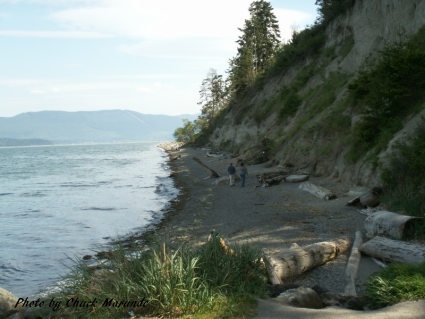There is some extraordinary Sequim high bluff property for sale, and I’ve been out showing and previewing some of these properties recently. The appeal of a Sequim high bluff property is obvious–a high water view of the Strait of Juan de Fuca or Sequim Bay or Discovery Bay. Some of these views are so extraordinary, you find yourself just standing on the bluff in awe. I showed one home on the bluff that was designed for this high bluff lot perfectly with a view from almost every room in the house.
Sequim High Bluff Property Dangerous?
If you fall in love with a Sequim high bluff property, your first question is likely to be something like this, “Is the bluff safe?” The issue of bluff stability and landslides will clearly be on your mind. Bluff stability is a complicated subject, but here are the relevant issues and how you as a buyer can approach this subject if you are thinking about buying a Sequim high bluff property.
Sequim High Bluff Property Stability
There are many factors that influence bluff stability, including bluff height, sediment type, slope, slope aspect, topography, vegetation, microclimate, waves, tides, sea level, drainage, surface water, ground water, weathering, earthquakes, and land use.
We have bluffs that are as high as 170 feet or more above the beach. We are fortunate that some of our bluffs consist of strongly compacted soil types, the result of glacial sediment that geologists say greatly compacted and strengthened many of our bluff areas. Slope aspect refers to the direction the bluff faces. Bluffs that face the north are less subject to erosion than bluffs that face the south because of the increased freezing and thawing action.
Some Sequim bluffs that are to the northwest of Sequim and outside the protection of the Dungeness Spit are exposed to substantially more wave action, tidal action, and in some areas are subject to underground run off from the Olympic Mountains. I’ve seen Sequim high bluff property that has virtually no vegetation, no trees, and no root systems for bluff stability.
Sequim High Bluff Property – Time to Move the House
There are several homes along the bluff between Sequim and Port Angeles that were built long before the 100 foot setback requirement, and some of those homes have had to be moved further back as the bluff eroded over many decades.
There are, in fact, miles of Sequim high bluff property that has been stable for as long as human memory serves. These are bluffs that are largely in protected Bays or protected areas along the Strait, and that have solid and well compacted sediment, do not have excessively steep slopes, have a lot of surface vegetation with deep large tree root systems, and do not have excessive underground water drainage out of the mountains. Many clients have told me that they have not seen any erosion at all on their bluffs in two and three decades. Others have said they’ve lost one or two feet.
You do have the option as a buyer to have a contingency in your purchase agreement that would allow you to hire a soils and bluff geologist. There is one such expert in Clallam County. He charges about $800 for an onsite analysis and a written report. In practice, very few buyers decide to front the money for a bluff stability report. Most buyers will get a verbal opinion, and talk to the sellers and neighbors to learn the history of the bluff, and then make a decision themselves.
Now you know a little more about Sequim high bluff property.
Last Updated on June 8, 2012 by Chuck Marunde






























Our high bluff property has been properly maintained & protected over the past 10 years since we bought it and developed our inn. We had a bad winter storm one year that uprooted a tall cedar that had its root partially exposed. As a result and in an effort to maintain our bluff, I took down a couple of the other trees that were in jeopardy. Here on this side of the Strait the normal erosion has been at a rate of 1 foot every 10 years (per residents who have lived here for most of their lives). That being said it would take 1000 years for a 100 foot setback to be eroded.
Excellent information and thank you very much Dan. Chuck Marunde